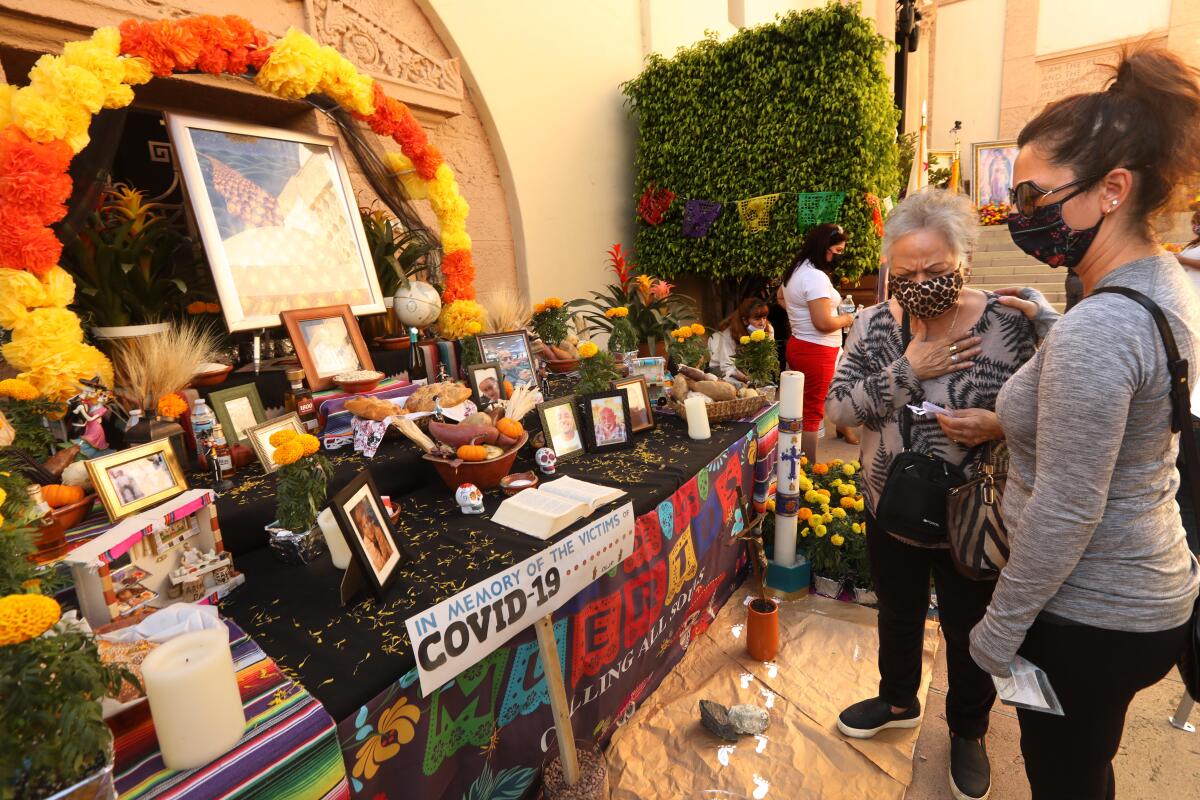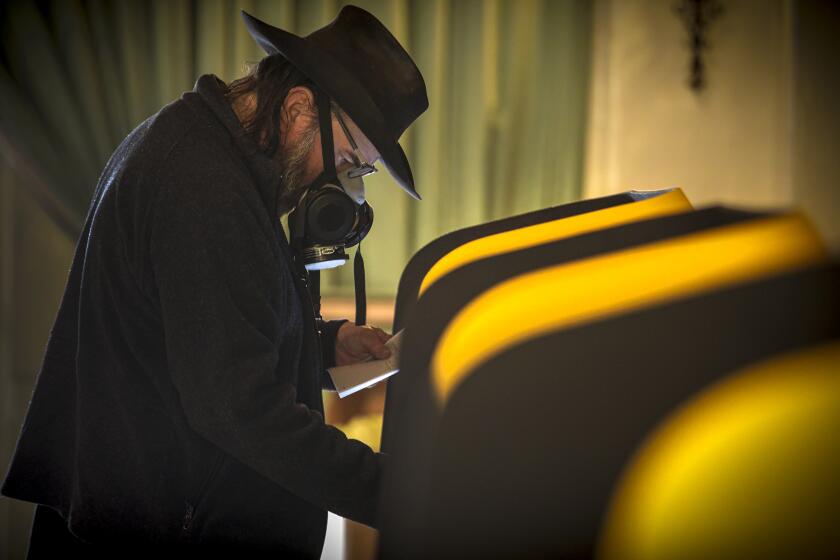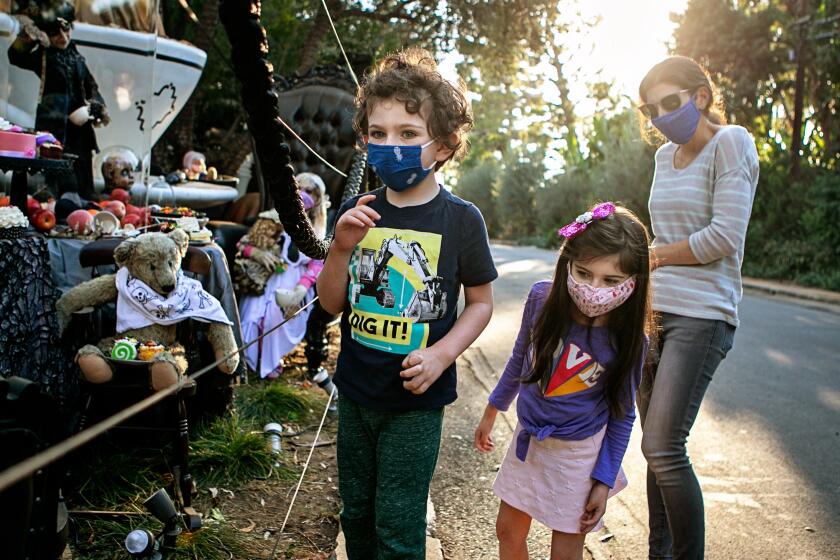California coronavirus cases outpaced by Texas, but state warns not to let guard down

- Share via
California is no longer the state with the highest number of coronavirus cases, as Texas officially surpassed the overall case count despite having 10 million fewer residents, data compiled by The Times show.
The Lone Star State’s leapfrog illustrates both the magnitude to which COVID-19 cases are surging there, and the extent to which California — so far — has escaped the significant spikes striking many other parts of the United States.
But with Halloween so recently in the rearview mirror and other holidays fast approaching, state and health officials continue to stress that residents and businesses need to do their part to stymie the disease’s spread and ward off any creeping sense of fatigue.
As of Monday morning, Texas had recorded 936,816 total COVID-19 cases — just above California’s 935,534, according to The Times’ coronavirus tracker.
When accounting for population, however, the difference between the two most populous states in the union becomes even starker. Texas has seen roughly 3,359 coronavirus infections per 100,000 residents, Times’ data show, while California has recorded 2,389.
Over the last seven days, Texas has reported 42,525 new COVID-19 cases — the most in the nation and well north of California’s 29,195, according to figures from the U.S. Centers for Disease Control and Prevention.
“We’ve got to overcome any sense of fatigue that we might have,” Dr. John Hellerstedt, commissioner of the Texas Department of State Health Services, said in a video message last week. “We have to understand how important this is, and I’m asking you, please, to redouble your efforts to take the precautions that we’ve asked you to do and that we have proven that work.”
Those include physical distancing, regular hand-washing, wearing masks in public and avoiding gatherings with too many people you do not live with, health experts say.
Los Angeles, Orange, Riverside and San Bernardino counties are all reporting increases in case rate.
Officials throughout California have been reciting a similar refrain for months and have been especially earnest as numbers of new coronavirus infections have rocketed to unprecedented heights throughout much of the nation.
Roughly 97,000 new cases were reported nationwide on Friday — an all-time high, according to the COVID Tracking Project. The previous record, about 88,500, had been set the day before.
“Case growth is far outpacing testing through the U.S., suggesting that current case surges are an indication of uncontrolled spread of COVID-19,” project officials wrote on Twitter.
While new case rates can illustrate how rapidly and widely the virus is spreading through a community, officials also have emphasized that the metric can be a harbinger of further devastation — as the numbers of those who die from the disease or fall ill enough to require hospitalization tend to correspondingly increase weeks after cases do.
Though it has yet to see the same sort of significant surges as some other states, California has seen some upticks in coronavirus activity.
The adjusted case rate for Los Angeles County, for instance, increased last week to 8 per 100,000 residents, up from 7.6 the week before.
In Orange County, which reported 233 new coronavirus cases and one death Sunday, the case rate ticked up to 5.1 per 100,000 residents from 4.6 the week before. Riverside County reported its most recent adjusted case rate at 10.1, up from 9.1 the week before. And San Bernardino County reported an adjusted case rate of 11.9, up from 10.9.
Though the increases are modest at this point, keeping them that way will require continued vigilance by residents and businesses, health officials say.
That’s especially true as the end of the year approaches, bringing with it both cooler weather that will force people indoors, where the coronavirus can more easily spread, and holidays where people would traditionally gather to celebrate with family and friends.
It will also take time to determine whether California will see any coronavirus increases stemming from activities or parties held on Halloween.
“It’s not just about who might get infected on Halloween as a result of an ill-advised party, but also about the people that will come in contact with that person in the days to follow,” L.A. County Public Health Director Barbara Ferrer said in a statement. “The stakes are high since our case numbers have already been steadily increasing for the past two weeks. We can’t really afford to repeat what we went through after the July Fourth holiday when we saw surges in cases followed by alarming increases in hospitalizations and deaths.”
Halloween is shaping up to be a do-or-die moment for California, which is fight to avoid a fall surge in cornavirus.
Another challenge health officials are contending with, as Hellerstedt mentioned, is coronavirus fatigue. It’s been more than seven months since Gov. Gavin Newsom issued his initial stay-at-home order, and the messaging surrounding infection prevention measures may no longer carry the same potency for some pandemic-weary Californians.
Though optimism is in short supplies these days, it’s also important to “recognize how well California is doing,” said Paula Cannon, a professor of molecular microbiology and immunology at the Keck School of Medicine at USC.
“Take a look at the graphs and the charts for California compared to many, many other states and just recognize that, for the most populous state and for the most populous city in the most populous state in Los Angeles, we are doing a phenomenal job,” she said in a recent interview.
That’s not to say “everybody can let their guard down,” she emphasized, but Californians should still “recognize that this is working. All the sacrifice is meaningful, and it’s working.”
Times staff writer Alex Wigglesworth contributed to this report.
More to Read
Sign up for Essential California
The most important California stories and recommendations in your inbox every morning.
You may occasionally receive promotional content from the Los Angeles Times.
















